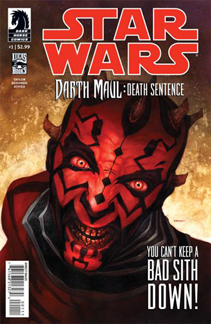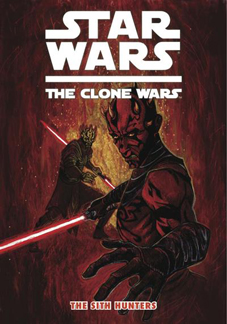While this year’s “Darth Maul: Son of Dathomir” is a continuation of Maul’s “Clone Wars” TV arc, taken directly from unproduced Season 6 scripts, Dark Horse Comics also released two Maul stories in 2012 that nicely filled in the gap between Seasons 4 and 5: “The Clone Wars: The Sith Hunters,” the ninth of the 11 “Clone Wars” digests nominally aimed at younger readers, and “Darth Maul: Death Sentence,” a four-issue series.
In the Season 4 finale, “Revenge,” Maul seeks vengeance against Obi-Wan Kenobi for cutting him in half in “The Phantom Menace.” In Season 5, Maul begins to play a longer game, seeking a base of allies and wealth so he can plan for revenge on both Obi-Wan and Darth Sidious from a position of power. As he tells his brother, Savage Opress, in “The Sith Hunters”:
“In a time of galactic war, history has shown there is an opportunity for smaller factions to accumulate great power and wealth without being noticed. … There will be more than enough time to exact our vengeance, once we have the means to properly execute it.”
In Season 5 up through the Season 6 “Son of Dathomir” comics, Maul enlists the help of Black Sun, the Pykes, the Hutts and the Mandalorians. “The Sith Hunters” and “Death Sentence” are his previous attempts to acquire wealth, though he’s not aggressively seeking allies at this point.
The 76-page digest “The Sith Hunters,” written by Henry Gilroy and Stephen Melching (veterans of the “Clone Wars” TV series), finds Obi-Wan dropping off temporary ally Asajj Ventress and then teaming with other Jedi on another mission to capture the Zabrak Nightbrothers. The highlights are two sequences that fill in plot holes from the TV series.
First, we see Maul falling into the Theed generator station shaft, then packaged into what is presumably a waste container that is loaded onto a drone ship. The narration is Obi-Wan speculating to a young Jedi about how Maul survived: “I believe Maul’s rage was so powerful, and his knowledge of the dark side so great, he simply refused to die. But it is not impossible that ‘other forces’ contributed to Maul’s survival.” The visuals come from Maul’s “dream terrors,” as Opress puts it.
Second, we see Palpatine’s reaction when Anakin tells him Maul survived. The chancellor is clearly shocked, and this should put to rest any suspicion that Sidious had a role in Maul’s resurrection — although it will be clear later in Season 5 when he attacks Maul. (The “other forces” Obi-Wan speaks of, if they played a role in Maul’s survival at all, would presumably be Mother Talzin and the Nightsisters.) Over illustrations of Maul landing on the garbage planet Lotho Minor, being saved by the snake creature and making his spider body, Anakin correctly theorizes to Palpatine about Maul’s next step:
“I think (Maul’s quest for revenge against Obi-Wan) is only the beginning. As soon as he’s able, he’ll seek out what all Sith seek – fame, fortune and power.”


“Death Sentence,” written by Tom Taylor, finds Obi-Wan and a team of Jedi we’ve mostly never seen before on a two-pronged mission: To continue their search for Maul and Opress and also investigate mining magnate Ja’Boag, a financial ally of the Republic who might be committing atrocities against the people of the mining planet Moorjhone. A local prophet believes that a “demon in the light” will save them, and the Moorjhoni think Maul is that demon. It’s actually the good Jedi, Master Judd, a blue-skinned Trandoshan. (For eagle-eyed readers, the young Jedi Dray will appear again as an old man in Taylor’s “Invasion” comics.)
Continuing to show Maul’s instability from late Season 4, when Maul is saved from the blazing-hot desert by the cave-dwelling Moorjhoni, he is haunted by a nightmare not only of Obi-Wan but also of his own spider-legged self. In a cool moment that illustrates Opress’ wild rage, he slices open a carbonite canister that a Jedi throws at him and gets frozen in a carbonite block, mid-lightsaber swing. Of course, Maul later rescues his rage-aholic brother, setting the stage for Season 5.
While these two Darth Maul stories aren’t as crucial to the continuity as “Son of Dathomir,” they are remarkably substantial: They show Maul’s transition from nearly insane anger to a more thought-out plan, Sidious’ reaction to hearing that Maul is alive, and a depiction of Maul’s transition from his seeming death on Naboo to his arrival on Lotho Minor.

